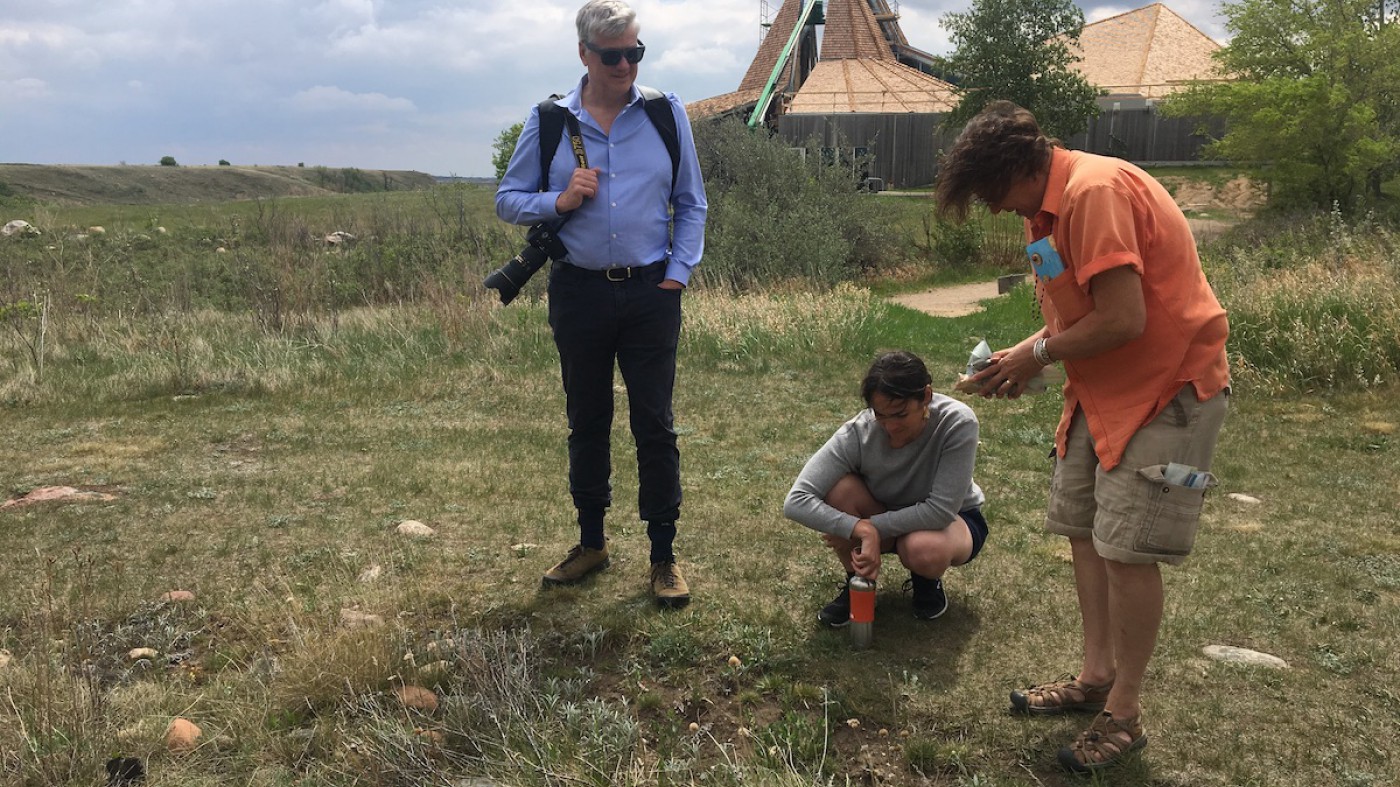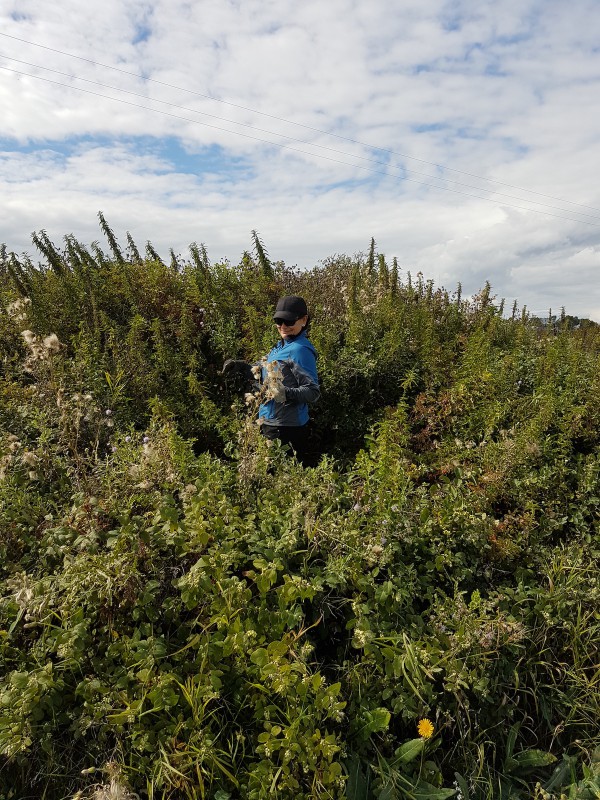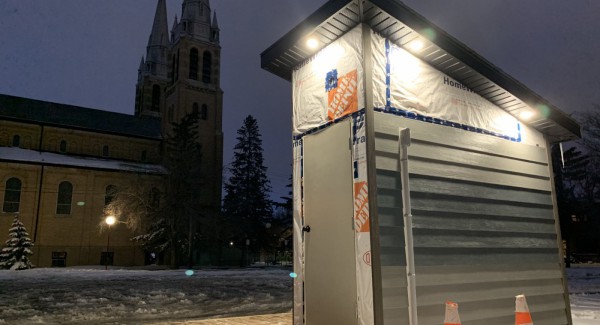Beyond just “saving the bees”

Examining the native prairie at Round Prairie Métis settlement. Photo courtesy of Sandra Walker.
The signal for growing season in Saskatchewan begins long before the ground has thawed. On a clear night in February, you can already see the Spring Triangle asterism rising above the horizon, indicating to people today, as it did millennia ago, that the time to begin planning for planting is near.
Getting a head start is crucial for a successful year of food gardening in the short, hot Saskatchewan summers. When I began urban gardening seven years ago, I was drawn by the allure of growing food for my young, financially precarious family. Not that our modest backyard garden bed produced enough to sustain us year-round, but it helped to supplement store-bought dinners with fresh tomatoes, peas, green lettuce, and radishes straight from the ground. Access to healthy and nutritious food is crucial to families struggling financially. This is particularly relevant here in Saskatchewan, where six in 10 residents are within $200 from being unable to pay their basic bills each month.
Growing and harvesting food from our environment is an ancient idea that holds promise for future food security, but there is an essential piece that is often overlooked in mainstream, especially urban, gardening practices – the interdependence of people, plants, and pollinators.
Feeding people and pollinators
A few days after I first spotted the Spring Triangle rising above the horizon in February 2021, my application to join the David Suzuki Foundation’s Butterflyway Project was accepted. The project is a national initiative that mentors enthusiastic gardeners (whom they call “Rangers”) in growing gardens that provide food and habitat for pollinator insects – butterflies, moths, bees, flies, and many others.
For decades, horticultural science has known that local pollinators are essential to the success as well as quality of crops. The U.S. Department of Agriculture estimates that about 75 per cent of all flowering plants and 35 per cent of food crops worldwide depend on animal pollinators to reproduce. And yet the current situation of pollinators is dire. Globally, 40 per cent of insect species are near extinction. The disappearance of pollinators will mark the end of food security for humans across the globe, as well as the collapse of whole ecosystems that depend on pollinator-plant relationships. It does not get more existential than that. The Butterflyway Project aims to create urban corridors of biodiverse gardens that sustain pollinators with abundant food and shelter during their seasonal travels.
Wealthier neighbourhoods reported more urban biodiversity, having more resources to cultivate diverse flowering plants that attract pollinators.
As part of my groundwork for Butterflyway, I converted my sizable boulevard into an edible blend of lupines, milkweed, bergamot, and wild onion. The City of Saskatoon’s boulevard gardening guidelines are remarkably straightforward and were recently improved after community consultation. The city’s Bylaw No. 8175 also specifically protects native plants from being identified as “overgrown” nuisances and removed by the city.
The crux of the Butterflyway Project is that gardens within city limits represent an urban refuge for pollinators whose traditional habitats have been destroyed. What is good for pollinators is ultimately good for gardeners and the communities they feed. In a British study of 360 residential and community gardens across four cities, a research team found that these gardens served as “hotspots” for pollinators similar in scale to nature reserves, cemeteries, and public parks. They also found that pollinator abundance in neighbourhoods differed by household income. Wealthier neighbourhoods reported more urban biodiversity, having more resources to cultivate diverse flowering plants that attract pollinators. This study identified an important connection between wealth, biodiversity, and food security, and its authors wrote that “This finding suggests that initiatives to support pollinators in lower-income neighbourhoods could help to reduce inequities in the distribution of pollinators and the delivery of pollination services within cities.”
Food security for all
Lorraine Johnson is an international leader in what has been dubbed “ecological gardening,” which she describes as a shift in thinking “from how do gardens look to what can they do?” She recounts in her book City Farmer: Adventures in Urban Food Growing that during times of conflict and economic recession in the 20th century, waves of government-led campaigns encouraged city residents to grow urban food gardens. In an interview with the Sask Dispatch, she says, “these garden mobilizations didn’t last; we need to find a way to make them stick.”
In the first decades of the 21st century, marked by both global recessions and a global pandemic, we need that same political will to mobilize communities toward local food security. Johnson recently penned a Toronto Star op-ed, originally titled “A pandemic gardener’s manifesto,” which she says she was prompted to write “after seeing the disproportionate effects of the pandemic on marginalized communities.” She wants readers to realize “just how inseparable the social and the ecological practices of gardening are.”
This is a clear rallying cry for creating habitats – public and private – that feed people and pollinators in the spaces where urban poverty is most concentrated. Although the Butterflyway Project does not emphasize the link between pollinators and food security as well as it could, local initiatives better understand and can better mobilize municipalities to bring these priorities together.
This is a clear rallying cry for creating habitats – public and private – that feed people and pollinators in the spaces where urban poverty is most concentrated.
To some extent, Saskatoon is working toward such ends – offering individual allotments, community gardens, and vacant-lot gardens that are open to non-profits with a food security mandate. One of those non-profits, CHEP Good Food, coordinates a vast community garden network in Saskatoon, including the askîy (Cree for “earth”) project that repurposed an empty lot in Riversdale to teach Indigenous and non-Indigenous youth how to grow, harvest, and sell their own food.
Still, there is much work required of City Hall to make their gardening and parks programs more equitable. The City of Saskatoon currently has eight naturalized parks, which aim to create biodiverse, public “urban refuges” within city limits. However, none of these parks are in lower-income areas of town. That means pollinators and their services to flowering and food plants – as well as the pleasure and beauty of wild spaces – are shut out of the neighbourhoods that need them most.
Vanessa Young, coordinator of the Gardening at USask education and outreach program, points out that there are many ways to bring pollinators to the yard. She refers me to a meta-study review of whether native species attract more pollinator activity in urban habitats; it found that the size, diversity, canopy cover, and verticality of habitats made a bigger difference than plant origin. The availability of corridors between them also matters a great deal.
Young shared with me a crucial tip: “Stay the hell away from packets labelled as wildflowers unless they are supplied by a native seed supplier.”
Young sums it up this way: “You need diversity in your garden, regardless of origin. Most of our pollinators are generalists who feed on many different plant species. What pollinators need most is food throughout the growing season and so planting flowers with varying bloom periods helps to sustain them over time.”
The Gardening at USask program emphasizes no-till, no-pesticide gardening, using compost and mulching to enrich the soil. It has a YouTube channel packed with videos that cover germination techniques, composting, Indigenous understandings and uses of plants, even seed packet shopping. (Young shared with me a crucial tip: “Stay the hell away from packets labelled as wildflowers unless they are supplied by a native seed supplier.”)
“All plants are medicine"
Saskatoon has many local initiatives and experts who are teaching the next generation how to better steward and sustain the land. The Brightwater Science, Environmental and Indigenous Learning Centre, a program run by the Saskatoon Public Schools (SPS) system, offers land-based education for middle and high school students. Each year at the centre, about 3,000 students, teachers, and volunteers participate in ecological education that combines Western science with Indigenous teachings and ceremonies on 160 acres of land just south of Saskatoon. The program has existed for 30 years and an on-site centre was built in 2013, thanks to funding from the SPS Foundation and Nutrien.
(It is important to note that Nutrien is a global fertilizer company whose products can affect soil acidity and nutrients, as well as put pollutants into the air and water. They risk greenwashing such practices, which occur on a much larger scale than the local eco-solutions they fund. It does no service to the aims of ecological gardening to support ecological education in your backyard while actively harming ecosystems worldwide.)
“Think about teaching a language about a land that is not there. You can’t teach ecology without an ecosystem.”
Elizabeth Bekolay, who works with Brightwater and owns an ecological education and design company known as Lichen Nature, says that learning how to better steward the prairie grasslands starts with working with the land and developing a relationship with it. “Think about teaching a language about a land that is not there. You can’t teach ecology without an ecosystem.” We cannot fully appreciate our interconnectedness to the land without touching, smelling, and tasting the flora that make our existence possible.
Bekolay’s educational work involves finding creative ways to preserve and restore native habitats, like “eco-salvaging” plants from construction sites set to strip the land of its flora. I managed to successfully eco-salvage some silverweed from a construction site down the block, transplanting it into an empty patch in my backyard. Whether you ask for permission or not is a choice I leave to readers; however, eco-salvage could be formalized through partnerships between urban developers, construction companies, and conservation and gardening groups.
Part of the unlearning we need to do is around our attitudes toward plants we actively try to remove. During our interview, Bekolay said, “All plants are medicine. They may not be medicine for you, they could be for a pollinator, or for the soil.” Dandelion, for instance, is a pollen and nectar source for bees and white clover puts nitrogen back in the soil, reducing the need for fertilizers. We cannot forget that these benefits to pollinators and the soil come back to us in the form of healthier and more robust plants.
Walker remembers a young boy she met at Brightwater who, upon hearing that cattail pollen was a good source of protein, approached her in astonishment and asked, “You mean, I can go down to the river when I’m hungry and feed myself?”
Of course, we can also just eat our way through many of our so-called weeds, says Sandra Walker, a local ethnobotanist and author of The Path to Wild Food. She also works with Brightwater, as well as with Wanuskewin Heritage Park, Whitecap Dakota First Nation, and Round Prairie Métis settlement. She educates people of all ages in how to identify and respectfully harvest the foods that surround us, as well as how to grow them in the peculiar ecosystem of the city.
Exploring Wanuskewin Heritage Park. Photo courtesy of Sandra Walker.
Walker remembers a young boy she met at Brightwater who, upon hearing that cattail pollen was a good source of protein, approached her in astonishment and asked, “You mean, I can go down to the river when I’m hungry and feed myself?” Before colonization, there were more than just cattails along the water’s edge; Walker notes that “people don’t realize that grapes used to grow all along the riverbanks all the way from Ontario to here.”
Local food sources are especially important in communities impacted by poverty, oppression, and food insecurity. Talking about the City of Saskatoon’s naturalized parks in wealthy communities, Walker says, “If it’s about reconciliation, plant them in the communities that need them.”
How can gardening support reconciliation?
Winnie Hwo, the B.C. lead for the Butterflyway Project, says that the project is based on a core principle: “We believe the solution is in nature when it comes to helping the environment. This project helps to empower people to help pollinators and the environment around them.” Based out of Vancouver, Hwo is working with Butterflyway Rangers in B.C. to collaborate with the Musqueam Indian Band to learn the Halkomelem names and traditional uses of native plants in the area.
The promise of the Butterflyway Project’s mission resonates with me here in misâskwatômina, on Treaty 6 territory. Saskatchewan is home to the temperate grasslands, one of the world’s most threatened ecosystems. As Candace Savage, a long-time prairieland voice for conservation, wrote in her book Prairie: A Natural History, “human beings have hit the prairies with the force of a major geological crisis […] the Great Plains Grasslands now rank as one of the most extensively altered ecosystems on Earth.”
“The only possible solution” to secure the prairie ecosystem, beyond preserving what little pockets still exist, is “wherever possible, to create blocks of habitat large enough to support viable populations or to provide corridors between the existing fragments.”
Most, if not all, major threats to the grasslands are products of settler colonialism. According to National Geographic, among the biggest threats to the grasslands are urban development, alongside global warming, invasive species like the Russian olive tree and absinthe wormwood, and harmful agricultural practices like monocropping and pesticide use. Savage writes in Prairie, “The only possible solution” to secure the prairie ecosystem, beyond preserving what little pockets still exist, is “wherever possible, to create blocks of habitat large enough to support viable populations or to provide corridors between the existing fragments.” The urban refuge of city gardens are viable spaces for restoring native plants, especially edible and medicinal species.
The restoration of local habitats and the foods and medicines they provide needs to be grounded in reconciliation, guided by Indigenous knowledge and connection to the land. Too often, environmental projects from colonial organizations clash with Indigenous ways of stewarding and cultivating the land, despite growing global evidence that biodiversity is best preserved by Indigenous stewardship. Ecological gardening projects are no different insofar as they risk centring the interests and preferences of affluent, mostly white settlers over the needs of marginalized and colonized peoples. The placement of naturalized parks in the wealthier neighbourhoods of Saskatoon is a clear example of this kind of environmental whitewashing.
But how can gardening support reconciliation? Joseph Naytowhow is a nêhiyaw (Cree) storyteller and cultural advisor for Wild About Saskatoon, an organization that runs educational programming, such as their signature NatureCity Festival, focused on how to protect local ecosystems. He has helped create traditional medicine gardens at the University of Saskatchewan and has worked with the Meewasin Valley Authority to integrate Cree language and perspectives into their informational signs at nature preserves in Saskatoon. He says that the text of Treaty 6 has stewardship, conservation, and sustainability at its heart. The treaties bind Indigenous and settler coexistence to the enduring life of the grasses, the rivers, and the skies. When Indigenous stewardship is prioritized, Naytowhow believes that urban gardening projects can restore native lands, languages, and relations all at the same time.
Talking about the City of Saskatoon’s naturalized parks in wealthy communities, Walker says, “If it’s about reconciliation, plant them in the communities that need them.”
We have a new take on an old story: As we face widening inequalities and wealth gaps, we must once again return to the nurturing land and to each other to secure a future where food is available for all. That we include humans, plants – even weeds – and pollinators alike in our definition of food security is due to our mutual dependence on each other to survive.
While David Suzuki and his foundation often promote a bridge between Indigenous knowledge and Western science (for example, Suzuki has supported the national dialogue series Reconciling Ways of Knowing forum), it remains to be seen how well the Butterflyway Project will embody this belief in practice. Urban gardening has the potential to help curb the decline of pollinators, improve food security, and support more just and equitable relationships between settlers and the Indigenous people whose lands they live on. But in order for it to achieve those aims, urban gardeners will need to be intentional in their work.
This story was published thanks to a solutions journalism reporting bursary. Reporting bursaries are supported by Journalists for Human Rights and the Solutions Journalism Network, and made possible by funding from the McConnell Foundation.

